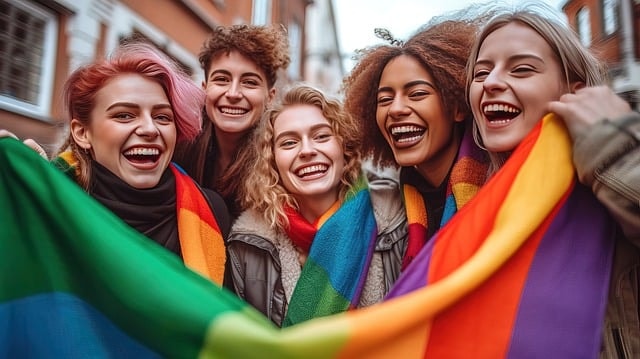Yes, is gay marriage legal in every US state? The answer is affirmative. This was made possible by the Supreme Court’s decision in Obergefell v. Hodges in 2015, which mandated that all states must recognize and issue marriage licenses to same-sex couples. Despite this ruling, some states still have unenforceable bans, making the legal landscape complex. In this article, we’ll delve into the current legal status, historical developments, and ongoing challenges related to gay marriage in the United States.
Table of Contents
Key Takeaways
The Supreme Court’s 2015 ruling in Obergefell v. Hodges mandated the nationwide legalization of same-sex marriage, overriding all state bans and requiring recognition of such marriages across the United States.
Despite the Obergefell decision, over 30 states still have constitutional amendments or statutes that ban same-sex marriage, which remain unenforceable but present a significant risk if the ruling were ever overturned.
Public support for same-sex marriage has significantly increased, with a 2023 Gallup poll indicating that 71% of Americans now favor it, reflecting broader societal acceptance and the importance of continued advocacy for maintaining these rights.
Legal Status of Gay Marriage in the US

Over the past two decades, the United States has seen a dramatic transformation in the legal status of same-sex marriage. In 2004, Massachusetts became the first state to legalize same-sex marriage, setting a precedent that would eventually lead to nationwide recognition by 2015. This shift was largely driven by a series of landmark court rulings that recognized marriage as a fundamental right guaranteed by the Due Process Clause and the Equal Protection Clause of the Fourteenth Amendment.
The fight for marriage equality marked a watershed moment with the Supreme Court’s decision in Obergefell v. Hodges. This 2015 ruling:
Struck down all state bans on same-sex marriage
Effectively legalized same-sex marriage across the entire country
Required states to issue marriage licenses to same-sex couples and recognize same-sex marriages performed in other states
This decision not only provided legal recognition to countless married same sex couples through civil unions but also affirmed their rights to the same legal protections and benefits enjoyed by opposite-sex couples, following the same sex marriage legalization.
The path to the legalization of same-sex marriage, despite the progress made, was anything but straightforward. It involved overcoming significant legal and societal hurdles, including numerous state bans and constitutional amendments that had previously attempted to define marriage as a union between one man and one woman. The Supreme Court’s ruling in Obergefell v. Hodges was a decisive step in ensuring that marriage equality was upheld nationwide, but it also highlighted the continuing need for vigilance and advocacy to protect these hard-won rights.
The Role of Obergefell v. Hodges
With its landmark decision in Obergefell v. Hodges, the landscape of marriage rights in the United States was fundamentally altered. On June 26, 2015, the Supreme Court ruled in favor of James Obergefell and his co-plaintiffs, who argued that Ohio’s refusal to recognize same-sex marriages performed in other states violated the Fourteenth Amendment. This ruling was monumental in extending the right to marry to same-sex couples nationwide.
In Obergefell v. Hodges, the legal arguments were primarily based on the Due Process Clause and the Equal Protection Clause of the Fourteenth Amendment. The plaintiffs contended that the refusal to recognize their marriages deprived them of both due process and equal protection under the law. The Supreme Court agreed, stating that the right to marry is a fundamental liberty that must be protected for all individuals, regardless of their sexual orientation. This decision mandated that all states must issue marriage licenses to same-sex couples and recognize same-sex marriages performed out of state.
Obergefell v. Hodges had an impact that simply cannot be overstated. It not only provided legal recognition and protection to same-sex couples across the country but also sent a powerful message about the importance of equality and non-discrimination. By affirming the rights of gay and lesbian couples to marry, the Supreme Court’s ruling in Obergefell v. Hodges marked a significant step forward in the ongoing fight for LGBTQ rights and marriage equality.
States with Pre-Obergefell Legalization
Several states had already taken steps to legalize same-sex marriage prior to the Supreme Court’s decision in Obergefell v. Hodges. Massachusetts was the first state to do so on May 17, 2004, following the Supreme Judicial Court’s decision in Goodridge v. Department of Public Health. This landmark ruling paved the way for other states to follow suit, gradually building momentum for nationwide marriage equality.
Connecticut joined the ranks of states legalizing same-sex marriage on November 12, 2008, after a state Supreme Court decision. Similarly, Vermont legalized same-sex marriage through legislation that overrode the governor’s veto on September 1, 2009. Iowa and New York also played crucial roles in advancing marriage equality, with Iowa’s state Supreme Court ruling in favor of same-sex marriage on April 27, 2009, and New York passing the Marriage Equality Act on June 24, 2011. These early adopters were instrumental in setting legal precedents and shifting public opinion.
In addition to these states, others like Rhode Island, Delaware, and New Mexico also legalized same-sex marriage through state legislation or court rulings before the Obergefell decision. The Human Rights Campaign (HRC) played a significant role in these efforts, particularly in New York, where their ‘New Yorkers for Marriage Equality’ campaign and large field operations were pivotal in passing same-sex marriage legislation. These early victories were crucial in laying the groundwork for the nationwide recognition of same-sex marriage that would come with the Obergefell ruling.
Existing State Bans on Same Sex Marriage
Over 30 states still retain constitutional amendments or statutes that ban same-sex marriage, despite the Supreme Court’s ruling in Obergefell v. Hodges, which declared same sex marriage unconstitutional. These same sex marriage bans were rendered unenforceable by the Obergefell decision, but they remain on the books. This means that if Obergefell were ever overturned, these bans could quickly be reinstated, stripping away the marriage rights of same-sex couples in those states.
Specifically, the legal landscape of same-sex marriage in the United States is as follows:
25 states have both statutes and constitutional amendments that prohibit same-sex marriage
5 states have constitutional amendments but no statutes
5 states have statutes but no constitutional amendments
This patchwork of legal restrictions underscores the fragility of marriage equality in the United States. If the regulation of same-sex marriage were returned to individual states, as it was prior to Obergefell, many states could revert to their pre-Obergefell bans, creating a fragmented and inequitable legal landscape for same-sex couples.
However, it’s important to note that not all states would be affected equally. Fifteen states, along with the District of Columbia and all U.S. territories, lack statutes or amendments prohibiting same-sex marriage. In these states, marriage equality would likely remain intact even if Obergefell were overturned. Additionally, bans in California, Hawaii, and Iowa would remain unenforceable due to previous state Supreme Court rulings. Nevertheless, the existence of these bans highlights the precarious nature of marriage equality and the importance of continued legal and political advocacy to protect these rights.
Public Support for Same Sex Marriage

Over the past few decades, public support for same-sex marriage in the United States has increased dramatically. According to a 2023 Gallup poll, 71% of Americans now support same-sex marriage, while 28% oppose it. This represents a significant shift in public opinion, reflecting broader societal acceptance of same-sex relationships and the rights of same-sex couples.
The trend towards greater acceptance is particularly pronounced among younger generations. A 2023 New York Times/Siena poll found that 70% of Americans support same-sex marriage, with support being higher among younger respondents. This generational divide suggests that public support for marriage equality is likely to continue growing in the coming years. Additionally, a 2022 Public Religion Research Institute poll indicated that a majority of residents in every state except Mississippi support same-sex marriage.
The increase in public support has been steady and significant. Since 1988, support for same-sex marriage has grown by approximately 1% to 1.5% per year until 2009, after which the rate of increase accelerated. This shift in public opinion has been instrumental in driving legal changes and ensuring greater protections for same-sex couples. The broadening acceptance of marriage equality underscores the importance of continued advocacy and education to maintain and build on these gains.
Respect for Marriage Act and Federal Protections
Signed into law in December 2022, the Respect for Marriage Act marked a substantial step forward in federal protections for same-sex and interracial marriages. This Act:
Replaced the Defense of Marriage Act, which had previously denied federal recognition of same-sex marriages
Mandates federal recognition of same-sex marriages
Ensures that same-sex married couples receive the same legal protections and benefits as opposite-sex couples.
One of the key provisions of the Respect for Marriage Act is its requirement for all U.S. states and territories to recognize the validity of same-sex marriages performed in jurisdictions where such marriages are legal. This means that same-sex couples who marry in states where same-sex marriage is legal will have their marriages recognized nationwide, regardless of the local laws in their home states. This provision is crucial in safeguarding the rights of same-sex couples, especially in states that still have bans on same-sex marriage.
Additionally, the Respect for Marriage Act includes provisions to protect religious liberty. It ensures that non-profit religious organizations are not required to provide services for the solemnization or celebration of a marriage. This balance between protecting marriage equality and respecting religious beliefs is a testament to the Act’s comprehensive approach to ensuring fairness and justice for all.
By codifying parts of Supreme Court decisions like Obergefell v. Hodges and Loving v. Virginia into federal law, the Respect for Marriage Act reinforces the legal foundation for marriage equality in the United States.
Impact of Potential Changes in the Supreme Court
Given its conservative majority, the current composition of the Supreme Court raises questions about the long-term stability of the Obergefell v. Hodges decision. Only two Justices who supported the Obergefell decision—Sonia Sotomayor and Elena Kagan—remain on the Court. This shift in the Court’s makeup has led to fears that the future of same-sex marriage rights could be jeopardized.
Justice Clarence Thomas has openly indicated that rulings protecting same-sex marriage could be targeted next, suggesting a potential for these decisions to be revisited. Similarly, Justice Samuel Alito has expressed concerns about the impact of Obergefell on religious liberty, further highlighting the possibility of challenges to the landmark decision. These statements underscore the precarious nature of the legal protections currently afforded to same-sex couples.
Additionally, cases related to transgender rights in red states could provide an opportunity for the Supreme Court to revisit and potentially overturn Obergefell. President Biden has emphasized the connection between the Dobbs decision, which overturned Roe v. Wade, and the potential threat to Obergefell, illustrating the interconnectedness of various civil rights issues. The evolving composition of the Supreme Court thus remains a critical factor in the ongoing fight for marriage equality and the protection of LGBTQ rights.
How State Laws Adapted Post-Obergefell
In the wake of the Obergefell decision, states had to modify their laws to guarantee equal marriage access for same-sex couples. Some states took proactive steps to explicitly update their marriage laws, ensuring that same-sex couples were afforded the same legal rights and benefits as opposite-sex couples. This included revising statutes and regulations related to marriage licenses, benefits, and divorce proceedings.
However, not all states adapted uniformly. Some state judges misinterpreted the Obergefell decision, believing it preempted state courts from handling marriage-related cases such as divorces. This misunderstanding created legal confusion and complications for same-sex couples seeking to navigate the legal system. Despite these challenges, states retained their authority over specific aspects of marriage law, as long as they did not discriminate against same-sex couples.
The Supreme Court’s ruling in Obergefell was intended to ensure equal access to marriage and its associated benefits for same-sex couples. However, it did not imply a complete federal takeover of marriage laws. States were still responsible for determining marriage benefits and governing divorces, provided they upheld the principles of equality and non-discrimination. This balance between federal oversight and state authority remains a crucial aspect of the legal landscape for same-sex marriage in the United States.
Challenges Faced by Same Sex Couples
Despite same-sex marriage being legalized, numerous obstacles continue to be faced by many same-sex couples. Discrimination and stigma persist in various facets of life, including the workplace, where individuals may face hostility or unequal treatment based on their sexual orientation. The fear of workplace discrimination remains a prevalent concern, highlighting the need for stronger legal protections and inclusive policies.
In addition to workplace challenges, same-sex couples often experience negative reactions within their communities. Hostile comments and actions can create an environment of exclusion and fear, undermining the sense of security that legal recognition of their marriages is supposed to provide. This cultural resistance underscores the reality that legal changes do not automatically translate to societal acceptance.
Many same-sex couples still face rejection from their religious communities, which can be particularly distressing given the importance of faith and community support in many people’s lives.
Moreover, the process of updating legal documents to reflect marital status can be fraught with complications for same-sex couples. Discrimination and unequal treatment in legal and administrative processes further illustrate the fragility of the current legal framework for LGBTQ rights.
These ongoing challenges emphasize the importance of continued advocacy and education to foster a more inclusive and accepting society.
HRC’s Efforts to Promote Marriage Equality
In the United States, the Human Rights Campaign (HRC) has been leading the charge for marriage equality. For years, HRC focused on changing hearts and minds across the nation, recognizing that legal victories alone were not enough to secure lasting change. Their efforts included sharing the stories of impacted couples and families, which helped to humanize the issue and build broader public support.
HRC’s campaign initiatives have significantly boosted their digital presence and outreach. The launch of their red logo in response to social media conversations led to over 18 million timeline shares and garnered 200,000 new Facebook followers and 67,000 new supporters. These efforts were crucial in mobilizing public opinion and generating widespread support for marriage equality.
In addition to digital campaigns, HRC consistently collaborated with coalitions such as the Respect for Marriage Coalition and United for Marriage to garner support at local, state, and federal levels. They supported rallies across the United States, including in front of the Supreme Court, and launched large field operations in states like New York to contribute to the passage of same-sex marriage legislation. HRC’s multifaceted approach has been instrumental in advancing marriage equality and continues to play a vital role in protecting the rights of LGBTQ individuals.
Learn more, visit Same-sex marriage – US Legalization, Equality, Rights.
Summary
The legal landscape of same-sex marriage in the United States has evolved significantly, particularly following the Supreme Court’s landmark decision in Obergefell v. Hodges. This ruling ensured that same-sex marriage is recognized across all 50 states, providing same-sex couples with the same legal rights and protections as opposite-sex couples. However, the existence of state bans and the current composition of the Supreme Court highlight the ongoing need for vigilance and advocacy to safeguard these rights.
Public support for same-sex marriage continues to grow, driven by generational shifts and increased societal acceptance. The Respect for Marriage Act has further solidified federal protections, ensuring that same-sex marriages are recognized nationwide. Nonetheless, same-sex couples still face discrimination and stigma, underscoring the importance of continued efforts by organizations like the Human Rights Campaign to promote marriage equality. The journey toward full equality is ongoing, and it requires the collective effort of individuals, communities, and advocacy groups to achieve lasting change.
Frequently Asked Questions
Is same-sex marriage legal in every US state?
Yes, same-sex marriage is legal in all 50 US states due to the Supreme Court’s 2015 decision in Obergefell v. Hodges.
What was the impact of Obergefell v. Hodges?
The impact of Obergefell v. Hodges was the nationwide extension of marriage rights to same-sex couples and the requirement for states to recognize and issue marriage licenses for same-sex marriages, affirming the fundamental right to marry for all individuals.
Which states legalized same-sex marriage before Obergefell v. Hodges?
Before the Obergefell decision, states such as Massachusetts, Connecticut, Vermont, Iowa, and New York had legalized same-sex marriage through state court rulings or legislation. These states were among the early adopters of same-sex marriage legalization.
What are the challenges faced by same-sex couples despite legal recognition?
Despite legal recognition, same-sex couples still face challenges like discrimination, community stigma, and lack of support from religious communities. This emphasizes the continued necessity for advocacy and legal protections.
How has the Human Rights Campaign (HRC) contributed to marriage equality?
The Human Rights Campaign has contributed to marriage equality by changing public opinion, collaborating with coalitions, and supporting rallies and campaigns across the US, which has been crucial in advancing legal protections and societal acceptance for same-sex couples.









